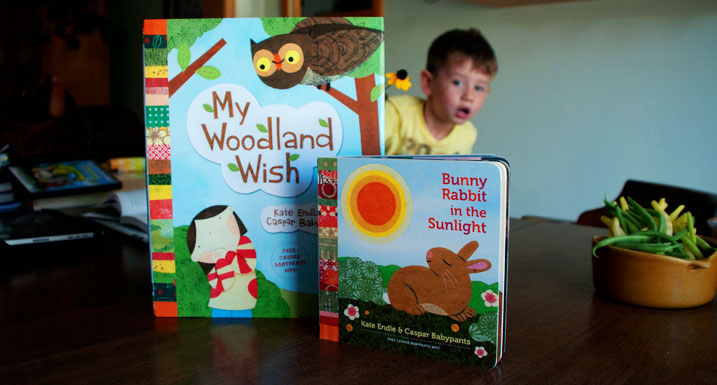
If your kids love Caspar Babypants‘ music as much as mine do, you’re doubtless already familiar with the work of his wife, artist Kate Endle. Not only has she been responsible for each Caspar Babypants album cover, she’s also a busy Etsy shopkeeper and thriving illustrator of children’s books like Trout Are Made of Trees and Bella and the Bunny.
Now, Kate and Caspar are expanding their partnership, and the first fruits of their labor are here: Bunny Rabbit in the Sunlight, a beautiful, simply written bedtime story, and My Woodland Wish, the tale of a girl who wishes she could play with the animals in the woods around her house. Both books come with a URL where you can download an mp3 to go with the story.
Both books are fairly similar, in that they focus on the outdoors, feature stories built from easy-to-understand rhymes, and include plenty of lovely Endle artwork. The main difference between the two is that Rabbit in the Sunlight is a board book, and the shorter of the two — it’s the kind of thing you’ll pull out before bed for your favorite toddler — while My Woodland Wish offers more of a full-fledged narrative.
Their differences are less meaningful than their similarities, however — both books capture the peaceful, gentle spirit of Caspar Babypants’ music, and feature some of Endle’s loveliest work. I took the books out on a Sunday morning when my kids were running wild, and they calmed right down, eagerly identifying animals on the pages and absorbing the soothing rhythm of the stories.
Both books have been beautifully assembled by Sasquatch Press, particularly Bunny Rabbit in the Sunlight, which was printed with a really pleasant-looking matte finish on the boards. They’re affordably priced — you can own them both for less than $25 through Amazon — and they come with some wonderful free music. Don’t miss the chance to help support a pair of talented independent artists (and give your family a couple of great gifts in the process).
![51NR43fS3yL._SCLZZZZZZZ_[1] 51NR43fS3yL._SCLZZZZZZZ_[1]](https://www.dadnabbit.com/wp-content/uploads/2009/09/51NR43fS3yL._SCLZZZZZZZ_1.jpg)
 Wendell Berry – Whitefoot: A Story from the Center of the World (2009, Counterpoint)
Wendell Berry – Whitefoot: A Story from the Center of the World (2009, Counterpoint)